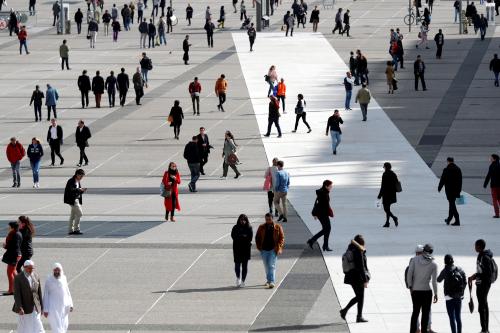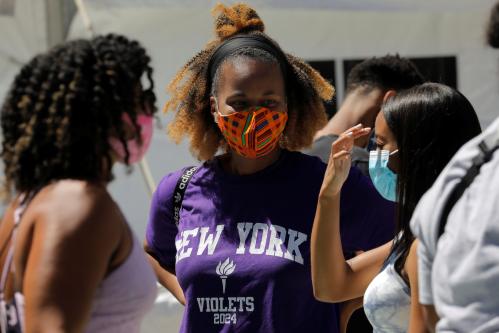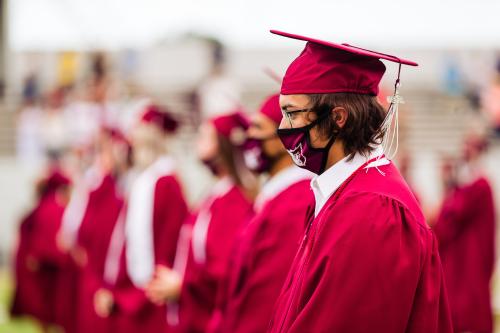If you want more content like this, subscribe to our newsletter.
This week in Class Notes:
-
- Merit-based aid increases college graduation rates and the expected lifetime earnings of low-income students.
- Children that move out of distressed public housing developments see long-term labor market benefits.
- There is significant upward and downward intergenerational mobility in self-reported health.
- This week’s top chart shows that 24 states are increasing their minimum wage in 2021, but only three will provide a “living wage.”
- The New York Times Editorial Board calls for a more equitable admissions process for the city’s selective high schools in this week’s choice op-ed.
- Check out our latest brief on how President Biden can begin to rebuild our divided nation.
- For your calendar: Attend upcoming events on the SALT deduction, promoting early childhood development, and race-conscious policies for a COVID-19 recovery.
Merit-based aid increases college graduation rates for low-income students
Every year, college students receive over $187 billion in federal and private aid. How much does aid help? The causal impact of that aid is difficult to measure given the many confounding variables. Joshua Angrist and his coauthors partnered with a private foundation in Nebraska to measure the causal effects of merit-based financial aid on college completion and lifetime earnings for low-income students. They designed an experiment in which 3,700 high school seniors were randomly selected out of a pool of low-income, academically-qualified students to receive full scholarships to attend a Nebraska public college. The scholarship increased BA completion by 8.4 percentage points. This effect is largely driven by an increase in the number of credits earned by aid recipients in their first year of college. Early and deep engagement with a four-year college program seems then to be critical for college completion. Additionally, the study finds that the gains in lifetime earnings are positive and exceed the marginal education costs and foregone earnings for aid recipients.
Children that move out of distressed public housing developments see long-term labor market benefits
The HOPE VI Demolition program was created by the Department of Housing and Urban Development in 1992 to demolish low-quality housing projects and help relocate existing residents to better neighborhoods. Using Census data, John C. Haltiwanger and his coauthors study the long-term effects of these moves on the children who were 10-18 years old when their projects were closed. The authors find that children who lived in HOPE VI projects had 14% higher earnings at age 26 than peers living in similar housing projects that were not demolished. Interestingly, the authors find that the HOPE VI program increased earnings for residents by improving their access to jobs; after demolition, most residents moved to neighborhoods that were as poor as their original ones, but geographically closer to better job opportunities.
There is significant upward and downward intergenerational mobility in self-reported health
Social scientists have widely studied intergeneration mobility in income, education level, and occupation. But how is health transmitted across generations? Timothy Halliday and his coauthors use longitudinal self-reported health status (SRHS) data from the Panel Study of Income Dynamics to estimate traditional intergenerational mobility metrics. They find that the rank-rank slope for SRHS is 0.26. This means that a 10 percentile increase in the parents’ rank in the SRHS distribution is associated with a 2.6 percentile increase in a child’s rank as an adult. Notably, this suggests there is more mobility in SRHS than in income, according to most studies on intergenerational income mobility. The study also finds that Black families experience both lower upward mobility and higher downward mobility in health than white ones.
Top chart: Minimum wages rise in 24 states, but nearly all remain below a living wage
This week’s top chart shows that while 24 states are increasing their minimum wage this year, all but three will provide less than a “living wage.” A living wage is calculated as the income level that allows an individual to afford adequate shelter, food, and other basic necessities.

Choice opinion: Reform New York’s unjust selective high school admissions practices
“Instead of allowing the pandemic to worsen longstanding inequities, New York could seize on the disruption to fix its broken high school admissions practices at all its schools. Several promising proposals have emerged in recent years. Instead of a single exam, Albany could allow the city to use state test scores, class rank and other measures.”
“Changing admissions policies to allow talented Black and Latino students — indeed, all students — a fair shot at attending the city’s top high schools should be the easy part. The far harder challenge facing the city in the coming years is how to prevent millions of children who were already vulnerable before the pandemic from falling far further behind,” writes the New York Times Editorial Board.
Separately, here’s what Ashley Schobert and I said on this issue in our 2019 piece.
Self-promotion: How Biden can rebuild a divided and distrustful nation
Joe Biden’s election to the presidency this November did not heal the wounds of division in this country. If anything, the election and the refusal of Donald Trump and his base to recognize the result, have further exposed the depth of our divisions. Americans are increasingly sorting themselves into incompatible tribes based on cultural identities in a way that threatens our liberal democracy. As the COVID-19 recession deepens and political rhetoric remains polarized, a series of broad policy reforms are needed to heal the divides and restore the “soul of America,” according to Isabel Sawhill. She proposes innovative solutions, such as a “scholarships for service” national service program to improve intergroup contact between Americans. She also suggests investing in better media literacy education and a more robust public broadcasting system to limit the spread of misinformation.
For your calendar: the SALT deduction, promoting early childhood development, and race-conscious policies for a COVID-19 recovery
Wednesday, January 13, 2021 2:00 PM – 3:00 PM EST
Thursday, January 14th, 2021 1:00 PM – 2:15 PM EST
Monday, January 25, 2021 4:30 PM – 5:30 PM EST
The Brookings Institution is committed to quality, independence, and impact.
We are supported by a diverse array of funders. In line with our values and policies, each Brookings publication represents the sole views of its author(s).








Commentary
Class Notes: Merit-based aid, rebuilding a divided America, and more
January 13, 2021